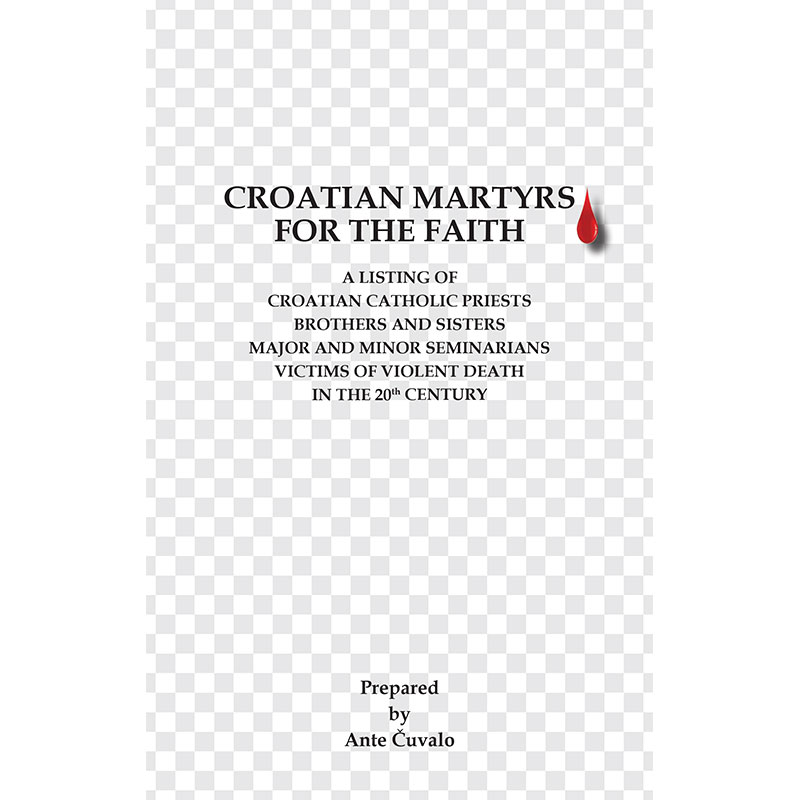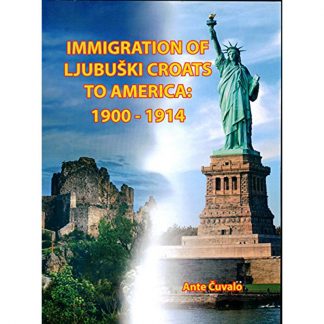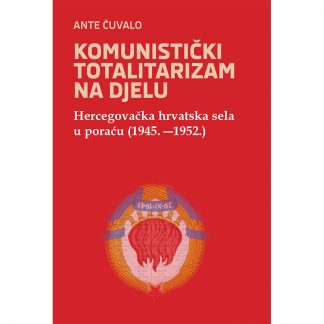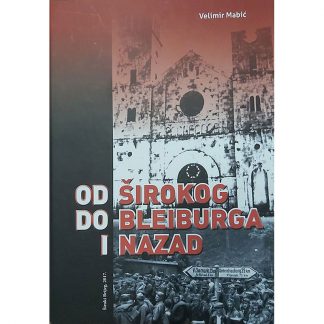Opis
INTRODUCTION
Totalitarian revolutionary regimes do not tolerate “others”. More specifically, the most dangerous “other” to Communists regimes is the Catholic Church and, consequently, Catholic clergy. A perfect example of such intolerance was the persecution of the Catholic Church in Croatia after World War II, by Tito’s Communist regime in the former Yugoslavia. Its aim was to decapitate the Church so it could more easily subjugate the people. The Yugoslav regime claimed that this persecution of the Church was initiated in order to “free” the people from the old bandages and to lead them to an earthly classless paradise. Thus, hundreds of Croatian priests, seminarians, religious brothers and sisters were sacrificed on the “altar” of the Revolution.
Marxism starts with the presupposition that God did not create the world but that we created God. Ironically, Marxists have created their own religion – albeit a secular one. This aggressive secular belief has its absolutes and dogmas; it has its prophets, apostles, martyrs and saints, heaven and hell; it has holy days, myths, rituals, theologians, missionaries, and heretics; it implemented a rigorous obedience to hierarchy wherever it took hold of power. A theory of dialectical process in history, correspondent to God’s guiding hand, drives its eschatology to the ultimate fulfillment of a new selfconsciousness and a new order of socialism and lastly utopian communism; an earthly Garden of Eden of our own making. Moreover, this state-created religion is not based on the preaching of love but on class struggle, bloodthirsty revolutions, terror, and fear – for the sake of an imaginary “blissful future”.
According to Marx, a belief in God is not only false (merely a projection of our needs and wishes) but most of all it is harmful to individuals and society at large. Marx claimed that religion serves as an opiate used by the oppressors to estrange (alienate) masses from their humanity. It is necessary, therefore, Marx writes, to free the people from God, from the traditional oppressive social order, from religion, and religious institutions that exploit the faithful who, in their inadequate consciousness, cannot recognize that religion is merely their own fantastic reflection and religious leaders and institutions their everlasting exploiters.
We do not know how Marx would have behaved toward the “enemies” of the Revolution if he had gained real power in some country during his time. We do know, however, that he advocated the elimination of some “unprogressive” nations (Croatians and some other Slavs, for example) for the sake of historical advancement, so we may presume that he would have used bloody means in order to speed up the dynamics of history, if he had a chance to do so. We also know for certain what his apostles (Lenin, Stalin, and the like) did to religious people and the Christian churches in the Soviet Union after the 1917 Revolution in the name of Communist “heavenly pastures.” Stalin’s disciples undertook similar steps in the so-called Eastern Europe after the Second World War, attempting to “catch up” rapidly with so-called Soviet “achievements” by any means, including executions and persecutions of religious people, intellectuals, “kulaks,” and other “enemies” of the Revolution.
Christianity, especially the Catholic Church, was perceived as the number one enemy and ruthlessly persecuted. In all the countries where the Communists came to power, an unconstrained hostility was unleashed against the Catholic Church and its leaders. Orthodox churches are national in jurisdiction (Greek, Russian, Bulgarian, Rumanian, Serbian etc.) and they were perceived as less dangerous and easier to compromise than a centralized Church lead by the pope in Rome. The Catholic Church’s central authority was outside the Communist domain, therefore, the Catholic clergy and the faithful were suspected of disloyalty and animosity to the particular Communist regime, and they were dealt with brutally. That was the main reason why the Archbishop of Zagreb and Primate of Croatia, Aloysius Stepinac, was persecuted by the Yugoslav regime. Tito, the Yugoslav Stalin, demanded that Archbishop Stepinac separate the Croatian Catholic Church from Rome, in order to make it subservient to the Communist regime of Yugoslavia. But the Archbishop stood firm and refused Tito’s demands. Because of his faithfulness to the Church, the Yugoslav regime condemned the Catholic Archbishop of Zagreb to sixteen years in prison. Forensic pathologists, subsequent to his death, determined that his jailers also slowly poisoned Cardinal Stepinac to death while in their custody – likely on orders from Tito himself.
Croatians
Croatian history is full of twists and often-tragic turns, especially after 1918. Namely, although the Croatian Kingdom recognized the Hungarian crown of St. Stephen in 1102 and the Habsburg dynasty as its sovereign in 1527, it preserved the core of its statehood from the medieval times until 1918. At the end of World War I, the Austro-Hungarian empire collapsed (along with the Russian, German, and Ottoman) and the Kingdom of Serbs, Croats, and Slovenes (renamed Yugoslavia in 1929) was formed by the world superpowers, and the prerogatives of the centuries-old Croatian statehood vanished. The new state was ruled by the Serbian dynasty and was subordinated to the Serbian political and military establishment. Furthermore, the Habsburg bureaucratic efficiency was replaced with a mix of Byzantine-Ottoman-Serbian traditions of corruption, clientelism, and police cruelty. Moreover, the Serbian Orthodox Church enjoyed a privileged status in the newly formed Yugoslav state.
The former Habsburg lands that were united with Serbia in the newly formed state were openly treated as conquered territories. Some among the Croatians (prior to the creation of the state) believed that Yugoslavia would be a union of equals and were supportive of the Yugoslav project, but it turned out to be a nightmare. Albanians, Macedonians, Muslims of Bosnia-Herzegovina, and especially Catholic Croatians were persecuted; their national and cultural identity was suppressed and denied. The Serbian Orthodox church vehemently opposed normalizing relations between the Vatican and Belgrade fearing that it would secure some basic rights for the Catholic Church. The persecutions culminated with the assassination (1929) of Croatian leading political figures in the Yugoslav Parliament building in Belgrade. All of this led to the radicalization of politics among the Croatians. Serbia’s relentless campaigns of terror led to the formation (1929-1930) of the revolutionary Ustasha (Rebel) movement, which advocated the destruction of Yugoslavia by any means and with anyone’s help. It was this movement that declared the Croatian Independent State in April 1941 under the auspices of the Germans and Italians. And, they were one of the main protagonists during World War II in Croatia and Bosnia-Herzegovina. While their primary struggle was to preserve Croatian statehood, major crimes were committed against the real and perceived enemies of the state. Croatians, including the Catholic clergy, desired an independent state but not under the Ustasha regime, nor under the sponsorship of Nazi Germany or Fascist Italy. However, in the eyes of the Yugoslav Communists any Croatian who stood for an independent state (democratic or even socialist) was depicted as being an Ustasha. These Croatians were persecuted, and often murdered, especially at the end of World War II and in the immediate post-war years.
The Chetniks were the leading military force among the Serbs during World War II. These paramilitary formations were officially formed in 1903 by Serbia’s military establishment. The main purpose of the Chetnik groups at the time was to spread terror in Macedonia, in order to “soften the ground” for Serbia to claim the land once the Turks were successfully pushed out of the Balkans. During the interwar era, the Chetniks were an unofficial arm of the Belgrade’s regime, used for spreading terror and fear in non-Serb regions of the country, mainly in Croatia and Bosnia-Herzegovina. During World War II, although they became the formal military force of the Yugoslav government exiled in London, they cooperated with Italian Fascists and German Nazis hoping to establish an ethnically pure Greater Serbia (that included Montenegro, Kosovo, Macedonia, Bosnia-Herzegovina, and most of Croatia). In their traditional warfare style, Chetniks committed major atrocities against civilians, including the Catholic clergy. Close to the end of the war, most Chetniks joined the Communist-led partisans in order to salvage at least some of the Serbian goals, even under the Communist regime. Such a move allowed them to cloak themselves as anti-fascists while covering up the crimes they committed before, during, and after the war.
Partisans, as a third major force in World War II operating in the arena of the former Yugoslavia, were a mixture of various ethnic and ideological elements that fought foreign occupiers and as well as their own domestic opponents. The Yugoslav Communists were neutral, while Hitler and Stalin were allies, and were able to impose themselves as the leaders of the partisan movement, after the Hitler-Stalin Nonaggression Pact failed. Their primary goals were to revive the Yugoslav state, impose a Stalinist-like regime in the country, and contribute their share to the Communist revolutionary dominance of Europe (and the world). Thus, anyone who opposed their Marxist ideology was labeled a fascist and collaborator and, therefore, deserved persecution, banishment, even death. They began to apply their bloody plan during the war and intensified it in the post-war years. The largest number of executions took place after the war when several hundred thousand Croatian soldiers and civilians, who sought the protection of British military forces in Austria, by surrendering to them, were instead forcibly repatriated back into Tito’s hands. While multitudes were forced into death marches, Tito’s forces committed genocidal executions at various locations throughout Slovenia, Croatia, Bosnia-Herzegovina, and further. Among hundreds of thousands executed without a due process of the law, during and after the war, there were almost 700 Croatian Catholic priests, religious, seminarians, lay brothers, and nuns also murdered.
Croatian Catholic clergy and religious killed during and after World War II
The Communists showed their true face in Croatia and Bosnia-Herzegovina early in the war. Any place they “liberated” also experienced the killing of Catholic priests, “kulaks” and influential people. Most of such executions had nothing to do with the war effort. These were punitive vicious actions against people who happened to be priests, lay brothers, nuns, teachers, store keepers… Some were murdered simply due to “guilt by association” – association meaning being a relative, friend, or neighbor of the aforementioned victims. The Communist Party of Yugoslavia banned all pre-WWII political parties and cultural institutions soon after the war’s end. The Catholic Church, although shaken, was the only institution that survived as a bulwark against the Communist revolutionary delirium. The Communists were, therefore, especially anxious to decapitate the Church in order to “clear the way” for a delusional new and “brighter future” for humanity!
During and after the war, the Catholic Croatians (the clergy and the faithful) were perceived as enemies on two main levels: as anti-Yugoslavs and anti-communists. Both were grave sins in the eyes of the atheist regime and both were viewed as treasonous. For example, while Cardinal Stefan Wyszyn´ski of Poland or Cardinal Jo´zsef Mindszenty of Hungary were treated as anti-communists by their respective regimes. They were prosecuted as enemies of an atheistic tyrannical regime, but not adversaries of the state of Poland or Hungary. Cardinal Aloysius Stepinac of Croatia, on the other hand, was seen as a symbol of both, anti-communism and anti-Yugoslavia. Anyone suspected of one or both “transgressions” against the regime was dealt with mercilessly. Labels as “fascist”, “collaborator”, and “enemy of the people” or “servant of the foreign forces” were a prelude to character assassinations in the public media. Once opponents were dehumanized through character assassinations the groundwork was laid for severe persecutions and real assassinations. Unfortunately, even the world media and most Western “specialists” accepted the Yugoslav regime’s practice of equating opponents of the Yugoslav regime and anti-communists with “the defeated dark forces from the past” and, thus, were always ready to excuse and deny Tito’s crimes.
The double-edged sword, anti-Yugoslavism and anti-communism, was used to execute more priests and religious among the Croatians, proportionately, than in any other nation that was subjugated to Communist totalitarianism. According to one source, the following number of “Church people” in various countries lost their lives during and after World War II: Nazi Germany 220; “Eastern Germany” 110; Slovenia 220; Poland 187 priests (from 1944 to 1989); Slovakia 14; Hungary “about ten”; Albania 67, and among the Croatians close to 700 Catholic priests, religious brothers, nuns, and seminarians lost their lives during and after the war.
Although the kangaroo court trials and various maltreatments of the clergy in Tito’s Yugoslavia is not the subject of this inquiry, the fact is that after World War II 262 Catholic priests were jailed in the notorious prison Stara Gradiška. Their combined jail terms that add up to 1,698 years, 9 months, speak loudly enough!3 This was only one out of many similar prison camps in the country where bishops, priest, and the religious were sent to be “re-educated”!
About this book
Prior to the declaration of Croatian independence in 1991, it was not permitted to do research, write, or talk about the killings of Croatian Catholic priests, or any other crimes committed by the Communists, in the former Yugoslavia. Thus, it was only through the work of Croatian emigrants in the West that limited information on the subject was brought to light before 1991. My interest in collecting data on the persecutions of Croatians in Yugoslavia (the Royalist and Socialist) and executions of Croatian Catholic clergy during and after the World War II began in the 1980s. However, that was never the focus of my studies, but a “sideline work.” A booklet Massacre of Croatian Clergy by the Yugoslav Communists and the Serbian Chetniks was published in Toronto by the Croatian Information Agency (Božidar Vidov) in 1981 that listed 335 victims among the Catholic clergy; 32 Muslim imams and hafizes; 8 Croatian Orthodox clergymen (a metropolitan, a bishop, and 6 priests), and one Evangelical bishop. Both, my collection of data and the names of Catholic clergy from the mentioned booklet were posted on my webpage (www.cuvalo.net) sometime in the 1990s.
So far, the most complete research dealing with the persecutions and murders of bishops, priests, seminarians, religious sisters and brothers was done by the late Rev. Anto Baković and published in the book Hrvatski martirologij XX. stoljeća, Zagreb: Martirium Croatiae, 2007. This large book of 978 pages contains the names, pictures, and biographical information of 663 religious people who were victims before, during, and after World War II. Out of that number, 4 were Catholic bishops, 506 priests, 50 students of theology preparing for the priesthood, 38 minor seminarians, 17 religious brothers, 31 religious sisters, and 17 priests who died of typhus while caring for the sick during the war.
I have prepared this reference booklet for the English-speaking world in order to make more accessible the names of the victims listed in Baković’s book, as well as in the above-mentioned booklet printed in Toronto (1981), and those that I gathered from various sources. The Baković’s book was my principal source because it is the most informative so far. However, I am including here a few names that are not found in Baković’s book but are found in the Toronto booklet, or that I have came across while reading various publications that touched upon the subject. I am not sure if Rev. Baković missed those victims while doing the research, or a few of them were wrongly listed in the Croatian emigrant publications. Although uncertain of their credibility, I will include their names as an addendum hoping that future research on the subject will determine if those additionally named were victims or not.
This listing contains 688 names. Out of that: 537 (+ 20 uncertain) victims of Communism, including 11 who died from 1948 to 1962 due to maltreatment while in Tito’s prisons; 45 victims of the Serbian royalist regime and the Chetniks; 26 of Anglo-American aerial bombings; 12 victims of German forces; 10 by the Ustaše regime; 2 by Italian forces; 19 from typhus during the war; 16 murdered by Serbs or Muslims during the 1992-1995 war (and after); and 1 killed during the Rwanda genocidal war of 1998.





